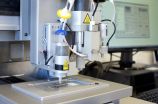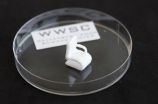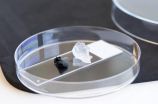(Press-News.org) A group of researchers at Chalmers University of Technology have managed to print and dry three-dimensional objects made entirely by cellulose for the first time with the help of a 3D-bioprinter. They also added carbon nanotubes to create electrically conductive material. The effect is that cellulose and other raw material based on wood will be able to compete with fossil-based plastics and metals in the on-going additive manufacturing revolution, which started with the introduction of the 3D-printer.
3D printing is a form of additive manufacturing that is predicted to revolutionise the manufacturing industry. The precision of the technology makes it possible to manufacture a whole new range of objects and it presents several advantages compared to older production techniques. The freedom of design is great, the lead time is short, and no material goes to waste.
Plastics and metals dominate additive manufacturing. However, a research group at Chalmers University of Technology have now managed to use cellulose from wood in a 3D printer.
"Combing the use of cellulose to the fast technological development of 3D printing offers great environmental advantages," says Paul Gatenholm, professor of Biopolymer Technology at Chalmers and the leader of the research group. "Cellulose is an unlimited renewable commodity that is completely biodegradable, and manufacture using raw material from wood, in essence, means to bind carbon dioxide that would otherwise end up in the atmosphere.
The breakthrough was accomplished at Wallenberg Wood Science Center, a research center aimed at developing new materials from wood, at Chalmers University of Technology.
The difficulty using cellulose in additive manufacturing is that cellulose does not melt when heated. Therefore, the 3D printers and processes designed for printing plastics and metals cannot be used for materials like cellulose. The Chalmers researchers solved this problem by mixing cellulose nanofibrils in a hydrogel consisting of 95-99 percent water. The gel could then in turn be dispensed with high fidelity into the researchers' 3D bioprinter, which was earlier used to produce scaffolds for growing cells, where the end application is patient-specific implants.
The next challenge was to dry the printed gel-like objects without them losing their three-dimensional shape.
"The drying process is critical," Paul Gatenholm explains. "We have developed a process in which we freeze the objects and remove the water by different means as to control the shape of the dry objects. It is also possible to let the structure collapse in one direction, creating thin films.
Furthermore, the cellulose gel was mixed with carbon nanotubes to create electrically conductive ink after drying. Carbon nanotubes conduct electricity, and another project at Wallenberg Wood Science Center aims at developing carbon nanotubes using wood.
Using the two gels together, one conductive and one non-conductive, and controlling the drying process, the researchers produced three-dimensional circuits, where the resolution increased significantly upon drying.
The two gels together provide a basis for the possible development of a wide range of products made by cellulose with in-built electric currents.
"Potential applications range from sensors integrated with packaging, to textiles that convert body heat to electricity, and wound dressings that can communicate with healthcare workers," says Paul Gatenholm. "Our research group now moves on with the next challenge, to use all wood biopolymers, besides cellulose.
The research findings are presented this week at the conference "New Materials From Trees" that takes place in Stockholm, Sweden, June 15-17.
INFORMATION:
The research team members are Ida Henriksson, Cristina de la Pena, Karl Håkansson, Volodymyr Kuzmenko and Paul Gatenholm at Chalmers University of Technology.
Astronomers have long theorised the existence of a first generation of stars -- known as Population III stars -- that were born out of the primordial material from the Big Bang [1]. All the heavier chemical elements -- such as oxygen, nitrogen, carbon and iron, which are essential to life -- were forged in the bellies of stars. This meansthat the first stars must have formed out of the only elements to exist prior to stars: hydrogen, helium and trace amounts of lithium.
These Population III stars would have been enormous -- several hundred or even a thousand times more ...
Scientists have developed a new tissue 'scaffold' technology that could one day enable the engineering of large organs.
Research led by the Universities of Bristol and Liverpool has shown that it is possible to combine cells with a special scaffold to produce living tissue in the laboratory. It is hoped this can then be implanted into patients as a way of replacing diseased parts of the body.
Until now, the approach has generally been limited to growing small pieces of tissue, as larger dimensions reduce the oxygen supply to the cells in the centre.
A team of ...
HOUSTON, June 18 -- Taking research from the lab to the clinic can be a long and arduous process, but necessary to ensure new therapeutic methods are safe. This typically involves models created in the lab to closely resemble the cellular mechanism of the human body.
Researchers at Baylor College of Medicine say they have now created a new disease model that more than just resembles the human mechanisms; it acts as a fully functioning human lipid system within a mouse to specifically study hypercholesterolemia, a form of high cholesterol caused by a genetic defect.
The ...
About a fifth of all U.S. children live in poverty. These children are more likely to experience learning and cognitive delays. Researchers have tried to determine causes for this disparity, with recent work identifying the hormone cortisol as a possible reason because of its ability to pass the blood-brain barrier. Cortisol is one of the most influential hormones in the human body, often referred to as the stress hormone because it's secreted into the bloodstream at higher levels as part of the body's flight-or-fight response. Now a new study has identified how specific ...
Teenagers vary substantially in their ability to control impulses and regulate their behavior. Adolescents who have difficulty with impulse control may be more prone to risky sexual behavior, with serious consequences such as sexually transmitted diseases and unintended pregnancies. A new study has found that individual differences in working memory can predict both early sexual activity and unprotected sexual involvement during adolescence.
Working memory -- the system in the brain that allows individuals to draw on and use information to plan and make decisions -- ...
Migraine researchers and clinicians are growing excited about a new class of drugs called Calcitonin Gene-Related Peptide (CGRP) monoclonal antibodies, which are showing promise in treating high-frequency episodic migraine and chronic migraine.
"This development is a transformative moment in migraine treatment," said Peter J. Goadsby, MD, PhD, who is chair of the scientific program of the American Headache Society's annual Scientific Meeting. Dr. Goadbsy is Chief of the UCSF Headache Center, and one of the world's leading headache treatment experts and researchers. ...
So perhaps there is some truth in the old legends of the underworld reeking of brimstone (or sulphur, as it is now called)? New research confirms that the Earth's core does in fact contain vast amounts of sulphur, estimated to be up to 8.5 x 1018 tonnes. This is about 10 times the amount of sulphur in the rest of the Earth, based on the most recent estimates (and for comparison, around 10% of the total mass of the Moon). This is the first time that scientists have conclusive geochemical evidence for sulphur in the Earth's core, lending weight to the theory that the Moon ...
During the coming monsoon season, survivors of the recent earthquake that destroyed parts of Nepal face a "very high" risk of a hepatitis E outbreak that could be especially deadly to pregnant women, according to a consensus statement from a group of infectious disease experts from around the world.
The document, published in the Lancet June 16 and signed by the Johns Hopkins Bloomberg School of Public Health's Alain Labrique and six others, states that the conditions in the April tremor that killed 8,800 people and injured more than 23,000 have left conditions ripe for ...
COLUMBUS, Ohio--Are black holes the ruthless killers we've made them out to be?
Samir Mathur says no.
According to the professor of physics at The Ohio State University, the recently proposed idea that black holes have "firewalls" that destroy all they touch has a loophole.
In a paper posted online to the arXiv preprint server [arXiv:1506.04342], Mathur takes issue with the firewall theory, and proves mathematically that black holes are not necessarily arbiters of doom.
In fact, he says the world could be captured by a black hole, and we wouldn't even notice.
More ...
An independent panel convened by the National Institutes of Health concluded that ME/CFS is a complex, multifaceted disorder characterized by extreme fatigue and many other symptoms (including impairment of memory or concentration, post-exertional malaise, and pain) which can result in disability and the loss of employment and family support. Furthermore, limited knowledge, insufficient research funding, and a lack of diagnostic tools diminish a clinician's ability to provide optimal care. This leaves patients burdened with the difficult task of finding a health care provider ...



